Practicing
Many difficult passages in the piano repertoire are based on recurring figures, or patterns. Such patterns usually lend themselves to one general solution, which can be made into a small “practice capsule”. Here we will propose “capsules” of this sort from the standard repertoire, referring both to the general principles involved and to specific ideas for practicing these passages.
Bach – Fugue in Ab+, WTC I (polyphonic playing)
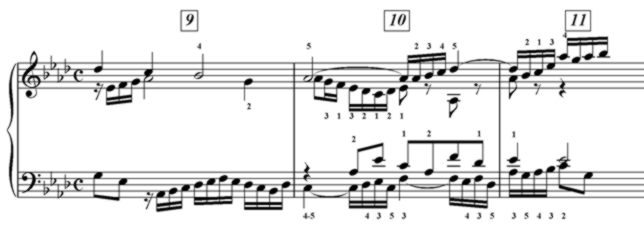
This kind of polyphonic passage, typical of many Bach fugues, requires the pianist:
- to play two contrasting parts in the same hand (m. 9, m. 11), and
- (more difficult) sometimes has the middle parts migrating, in mid-phrase or even in mid-motive, between the hands (m. 10).
The first difficulty should be mastered before attempting the second one. To master the first problem, seen here in the RH of m. 9, and the LH of m. 11, requires the ability to “split the hand in two”. It is best approached as follows (obviously, an appropriate fingering must be chosen in advance):
- play the two parts (e.g. m. 9, RH) first with two hands (i.e. one part played by each hand, leaving out the music on the other stave entirely), sharply exaggerating the difference between the two parts in dynamics, articulation, etc.
- imitate the sound of this exaggerated polyphonic playing, but now playing the two parts in the same hand.
- reduce the difference between the two parts, playing more subtly.
Once this has been mastered, you can approach the second, harder, problem. Here (e.g. m. 10) it is a good idea for beginners to actually rewrite the music with the correct hand distribution, as below.
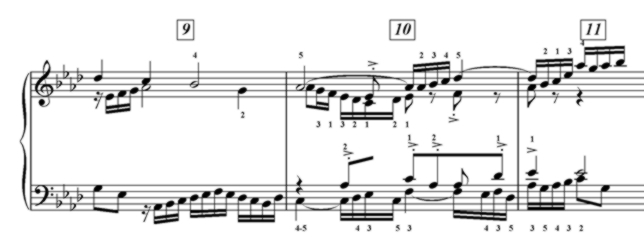
Note that the part which migrates between the hands (here mainly the tenor part) is marked with an exaggerated articulation, to better set it off from the other parts. To master this problem:
- practice the migrating part first alone, entirely with one hand,
- practice the migratiing part, with the final, correct hand distribution,
- practice each hand separately, playing both parts – the migrating part will of course be incomplete,
- practice both hands together, bringing out the migrating part very strongly.
- reduce the exaggerated articulation, playing more subtly.
Chopin – Prelude in F# minor (awkward shifts between black and white notes)

The difficulty here lies in the fast shifts and rather awkward positions.
Tips:
- Do not hold the thumb notes (RH) for their full value; the pedal sustains them anyway.
- Do not maintain either hand in the stretched positions required by the largest spreads any longer than required. The moments of relaxation afforded by allowing the hand to retract slightly will make a big difference over the whole piece. In the left hand either; move the arm, to remain “centered”
- For the movements between black and white note positions, required by the thumb (RH), begin the shift in or out (drawer shift) a few notes early. For example, on the first beat, by the time you are playing the notes B-A, the hand is moving out slightly to prepare the thumb for its coming D. The shift back in takes place as the high D is sounding.
- Move the thumb with a slight slapping movement t bring out its notes.
- Much variety of touch can result from the amount of finger action in the little notes (RH); they can be played either as waves, or as clear filigree.
Chopin – Scherzo #2, m. 680 ff (fast arpeggio figure with wide extension)

The difficulty here is a very common one in Chopin: a fast, wide cycling arpeggio pattern. This (pedaled) figuration sounds very rich. I have deliberately chosen the hardest bars here; if these are mastered comfortably, the surrounding measures are easy.
The wrong way to approach this passage is by stretching from the low Ab’s to the upper arpeggio notes.
What is required here is a freely swinging arm movement (feel the swing at the elbow). It starts from an outward position, with the 5th finger slightly on its side (on the the low Ab), and moves steadily to a slightly lower, inward position, where the thumb can play the highest note, and then reverses. The second note in each bar is played with either the 4th or the 3rd finger. What requires detailed work is the exact sunchronisation of the arm swing with the inner notes, so that each one can be played comfortably when it arrives. Given that there are many variants of the figure (changing with the harmony), these local adjustments need to be closely and clearly sensed at first. Finally, be aware that the last bar will require a fairly marked in and out (drawer) movement, due to the white notes. (The previous bar has the least drawer action, being entirely on the black notes.).
Chopin – Scherzo #2, m. 552 ff (frequent shifts from/into awkward positions)

There are two main difficulties within this short passage:
- the need to rapidly and accurately grab a handful of notes (in a chord, here) coming from a quick figure in a different position.
- the rapid shifts between the low and high register chords/octaves.
These two difficulties are best worked on separately, and then chained together.
First, practice playing the triplet and then grabbing the following chord. Simplify by omitting the middle notes in the right hand chord (see the musical example below). During the triplet each hand gradually opens out to prepare for coming chord. A split second before the arpeggiated octaves there is a very quick (arm) throwing movement to supply the requisite accent. Once this is comfortable, add the middle notes (again, see the example below).
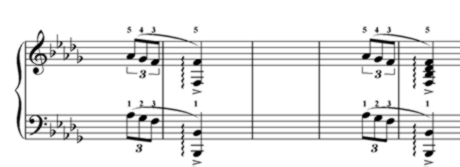
The next step (see below) is to practice the arpeggiated chord with a slightly exaggerated arm throw and a strong accent; but now feel the followthrough as being “ripped off the keys” and arcing rightwards in a sideways ellipse, landing on the high Eb.
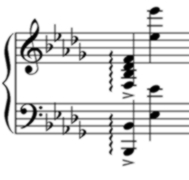
Next start from the high octaves (again, thrown); once again there will be a slight but distinct new attack before the accented arpeggio, as it is approached from the (now leftwards moving) ellipse.

Finally, chain all these mini-sections together in the actual passage as written.
Chopin – Scherzo #3, m. 39-41 (quick octaves in an awkward layout)
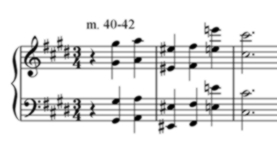
This quick octave passage is awkward due to its irregular layout and leaps.The first four octaves require only slight “drawer” shifts between white and black keys; if your hand is big enough, taking the (outer) black notes with the fourth finger and the white notes with the 5th finger will help provoke this automatically.
The large leap from F# to high E requires teaching the body to gauge the distance accurately. A good way to do this is to play the F# normally, and then to just touch the E, without actually playing it, as rapidly as possible. (This will feel less risky than normal playing.) After a few repetitions, you can play the E, and then add the surrounding notes.
Liszt – Paganini Etude #4, beginning (leaps and repeated notes)

The difficulty here comes from two elements (given the quick tempo):
- the left hand is constantly leaping,
- the repeated notes need precise timing, to avoid getting stuck.
The starting point is the LH leaps.

They should be played first alone (see above) with a fairly high wrist (since the LH plays above the RH throughout), and with a gently swinging arm rhythm. The arc described by the LH from note to note is assymetrical: after falling firmly onto its note, the LH rises, already moving sideways towards for the next note. The new note is played with a more or less vertical fall, and the process begins again, in the opposite direction. Here is the arc from lower note to a higher one; in the opposite direction it will be reversed.

Once you have absorbed the “mapping” of the leaps, and gotten used to the firm, bouncing rhythm of the LH, next incorporate the RH as block chords, as follows:

Then practice the following rhythmic modification (to sharpen the feeling of a quick lift off the first of each pair of repeated notes):

Finally, you are ready to play the music as written.
Liszt – Transcendtal Etude #11, m.100-102 (fast leaps between loud chords)

The main difficulty here is the rapid leaps in both hands.
A good starting point is the following two rhythmic variants. They should be played under tempo, however with the shifts made at full speed: Throw vigorously, stay on each chord until ready for the next, and then shift rapidly to play the next.

The arc described during the shift is assymetrical: after falling firmly onto its chord, the hand rises, already moving sideways towards for the next one. The new chord is played with a more or less vertical throw, and the process begins again, in the opposite direction. Here is the arc from lower chord to a higher one; in the opposite direction it will be reversed.

Given the very loud dynamic ( fff ) you may lean in slightly on the outer (melodic) chords. It is also useful to shape the phrase with a more pronounced lean into the peak chord on the third beat, and follow with a slight backward lean at the cadence. These movements should not be exaggerated!
After this preparation, you are ready to play the music as written.
Scarlatti – Sonata K. 141 (fast repeated notes)
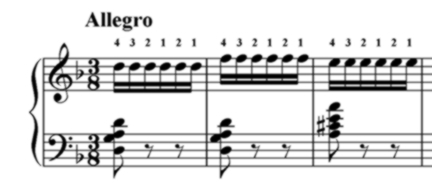
The difficulty here is the rapid repeated notes in the right hand.
To play this kind of consistent repeated note passagework, it is useful to position the hand and arm slightly outwards (to the right, in this case). This makes it easier to play the fingers quickly one after another. The releases are just as important as the attacks; it is critical to get off the notes quickly. A useful mental trick is to imagine that the descent of the new finger “causes” the withdrawal of the previous one. It may even be necessary to practice a few times with a slightly exaggerated lift of the withdrawing finger, although this should not be overdone; it can lead to strain.
The speed of the passage requires playing each bar as a group impulse. The left hand chords can be very useful to give the sense of a freshly renewed attack on each downbeat. Throw them vigorously; the RH will tend to follow the LH attacks.
Practice hands together, first as follows. Again, this encourages a fresh attack for each bar.
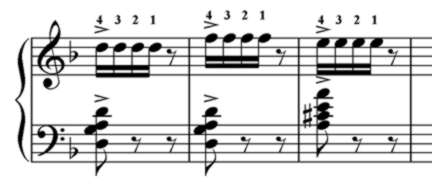
Then play the music as written. but stopping momentarily between bars. Finally, practice in whole phrases.
